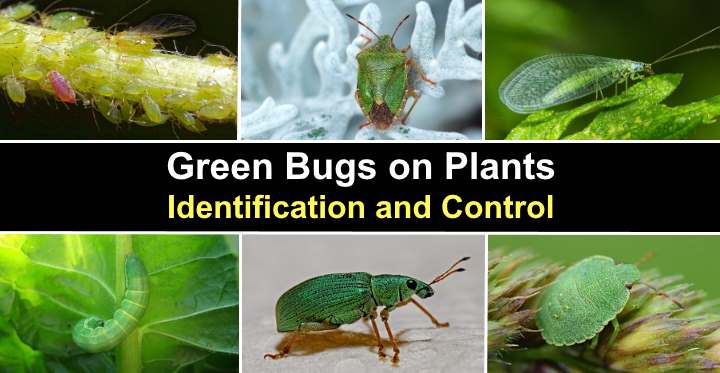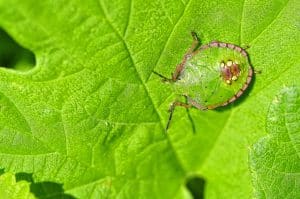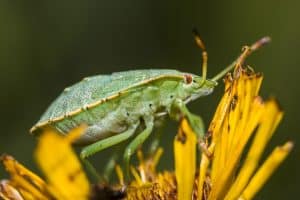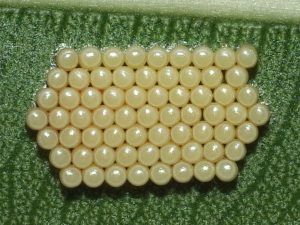Green Bug: What is it and How to Fight It? [Complete Guide]

 The green bug —Nezara viridula—, is a pest that affects a wide variety of herbaceous, fruit and ornamental crops and some cereals, especially wheat and soybeans.
The green bug —Nezara viridula—, is a pest that affects a wide variety of herbaceous, fruit and ornamental crops and some cereals, especially wheat and soybeans.
As in principle it does not leave apparent damage like other pests — caterpillars or ants for example — it usually goes unnoticed. Likewise, when it is still in the nymphal stage, it can be confused with non-harmful insects such as ladybugs.
However, the danger it represents is very high, since it not only depreciates the quality of the fruit but, if it is not controlled in time, it can cause a total loss of the harvest.
What is the green bug?
The green bug, as its name indicates, is a green pentatomid with reddish-brown antennae.
Some specimens show on the abdomen, or on the edge of their head, a pale rim of a shade similar to cream or yellow.
There are also brown and black specimens that correspond to younger stages, also known as nymphs. Some varieties are bright red.
Although its origin is estimated in Ethiopia, it is currently a fairly widespread species throughout the world. This, because it has great resistance in very long flights, so it can travel great distances.
In addition, its dispersion has been favored by the mercantile routes of ancient times.
Its body measures about 15 mm in lengthand is oval in shape, being longer than wide.
It is a polyphagous species, which is why it is found in a wide variety of crops. It feeds on the sap of more than 30 families of plants, although it has a predilection for those plants that are just fructifying or forming pods.
How to identify the green bug?
Main features
Thanks to their physical characteristics, green bugsthey find it easy to inhabit a crop undetected.They move easily and their flat bodies allow them to hide in fairly small spaces.
In addition, they adapt easily to different conditions, but prefer warm places. If the weather is right,An adult green bug lives for about two months.
If the weather cools, they may hibernate in leaf litter or any warm, dark recesses until spring.

Ways to identify a green bug infestation
One way to identify the presence of green bugs in crops is throughof the damage it causes.
Mainly, a quite characteristic stippling on the leaves. These leaves, when unfolding, tend to break quite easily in the area near the dotted areas.
When the plague is numerous, the fruits wither or show deformations and dark spots. In the case of wheat, the most affected areas are the leaves called «flag», which are those that are obtained in the axillary of the leaves.
Their presence can also be corroborated with a thorough inspection of the crop and rummaging through the stubble —remains of stems and leaves—, as this is one of the places they prefer to take refuge.
Green bugs usually lay their eggs on the underside of the leaves and a particular characteristic is that they do so in the form of a honeycomb. Thus, if we find small pale-colored balloons, arranged in a hexagonal shape, it is most likely that we are facing an infestation of green bugs.
Other considerations
Finally, the presence of green bugs can be identified by their foul odor. Bed bug glands secrete a rather peculiar, nutty, sweet but fetid and unpleasant odour.
Although they prefer to feed on plants, green bugs can also bite animals or humans. Its bite produces itching or itching, and is usually accompanied by redness and swelling of the skin,much like a wasp sting.
Sometimes several bites may appear in a straight line, although it is normal for them to be isolated bites.
Which plants are most vulnerable to green bug attack?
They feed on a wide variety of crops, the most affected being: tomato, cucumber, soybean, wheat, melon, grapevine, sesame, legumes, cotton and citrus.
Among the damages they cause are:
- Disease transmission.
- Risk of fungal or bacterial infections, such as Alternaria.
- Desiccation of the plant.
- Fruit growth stops or malformations occur.

How to fight the green bug?
- Biological control can be carried out by parasitoids such as Trichopoda pennipes, Trissolcus basalis, Hippodamia convergens, Telenomus spp. and Aridelus sp.
- Organic alternatives can also be used, such as nettle purin and Neem extract.
- Strict weed control must be maintained.
- Avoid adjoining plantations with different phenological cycles, as well as properly choose the time of planting.
- Keep the crop free of pest host plants.
- Manual collection of insects and eggs.
 1,197 Reviews COMPO Green Plant Fertilizer for Indoor Plants, Balcony and Terrace, Liquid Fertilizer with Potassium and Iron, 1.3 L
1,197 Reviews COMPO Green Plant Fertilizer for Indoor Plants, Balcony and Terrace, Liquid Fertilizer with Potassium and Iron, 1.3 L
- Stronger green plants: Fertilizer with mineral nutrients and extra potassium and iron for green plants of…
- Healthy growth: supply of essential nutrients from the first use, Promotes root growth and optimizes…
- Easy to use: Clean and safe dosage according to stages I to III marked on the lid (for 1-3 liters of water),…
- COMPO Quality: raw materials selected according to the original COMPO recipe, Strict quality controls by…
€7.49 View on Amazon Prices with VAT without transport
Last updated on 2022-07-26 / Affiliate Links / Affiliate API Images
121 Reviews Silberkraft Anti-bed bug spray for beds and mattresses (100 ml)
- ✅ Bed Bug Stopper: Our anti-bed bug spray fights bed bugs on your mattress, bed and other textiles immediately and…
- No permethrin: we do not deliberately bet on permethrin (poison) or similar substances. Our spray does not require signs…
- ✅ 100% free of propellant gas: all our aerosols are 100% free of propellant gas and act long-lasting without…
- ✅ TEXTILES-FRIENDLY: Our bedbug spray is water-based and won’t leave stains on surfaces and textiles. Without…
View on Amazon Prices with VAT without transport
Last updated on 2022-07-26 / Affiliate Links / Affiliate API Images
UEBER – Ready-to-Use Green Protection for bed bugs – Promotes the Displacement of Natural Plants – 500 ml spray
- Spray abundantly from a distance of approximately 20 to 30 cm on the windowsills.
- Repeat the treatment for three consecutive days and then on alternate days.
- Avoid ingesting and directly inhaling or spraying into the eyes.
- Domestic and civil use: the packaging, the composition specified above, the quality of the products used, as well…
View on Amazon Prices with VAT without transport
Last updated on 2022-07-26 / Affiliate Links / Affiliate API Images
home remedies against bedbugs
Some home remedies to keep green bugs away are:
- Use of mosquito nets.
- Garlic is a very effective natural pesticide. It is recommended to plant garlic cloves between the plants of the crop or use a decoction of garlic and spray from time to time at the base of the plants, during the night.
- Use non-woven fabric —bought at garden stores— to protect plants, creating barriers that prevent the arrival of green bugs.
39 Reviews Neudorff Spruzit Concentrated Insecticide-Acaricide, Yellow, 9x5x27 cm
- Certificate in Organic Agriculture
- Reduced security period
- harmless to bees
- Concentrated Liquid
€25.90 View on Amazon Prices with VAT without transport
Last updated on 2022-07-26 / Affiliate Links / Affiliate API Images
Products to combat bed bugs
We recommend you go to a local nursery or a specialized store. But if you don’t know or don’t have any nearby, you can also go to Amazon:
Neem Oil – TRABE Neemazal 250 ml €50.00 View on Amazon Prices with VAT without transport
 Castalia Potassium Soap, Potassium Solution… €22.95 View on Amazon Prices with VAT without transport
Castalia Potassium Soap, Potassium Solution… €22.95 View on Amazon Prices with VAT without transport
Last updated on 2022-07-26 / Affiliate Links / Affiliate API Images


![Photo of Purslane: [Crop, Associations, Pests and Diseases]](https://www.complete-gardening.com/wp-content/uploads/2022/08/purslane-crop-associations-pests-and-diseases-390x220.png)
![Photo of Hoya Linearis: [Planting, Care, Substrate and Irrigation]](https://www.complete-gardening.com/wp-content/uploads/2022/08/hoya-linearis-planting-care-substrate-and-irrigation-390x220.jpg)
